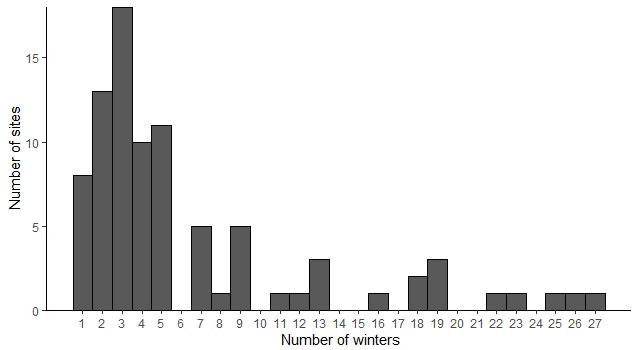
3 minute read
Low Tide Count Scheme Review
Low Tide Counts scheme review
After nearly 30 years of Low Tide Counts on UK estuaries, an in-depth review has been carried out to look at how the scheme could be improved in the future.
The WeBS Low Tide Counts scheme was initiated in the winter of 1992/93, with the aim to monitor, assess and regularly update information on the relative importance of intertidal feeding areas of UK estuaries for wintering waterbirds, with counts carried out between November and February. Since its inception, 87 estuaries have been counted at low tide, with the current recommendation that sites should be counted on a cyclical basis, every six years.
A review of the first seven years of the WeBS Low Tide Counts scheme was carried out by Musgrove et al.(2003), and provided detailed site accounts for the 62 sites covered in the initial years of the scheme.
Now, after being in operation for nearly 30 years, a new review of Low Tide Counts has been carried out. The purpose of this review was to better understand existing coverage over this period, as well as the outputs and user requirements so that recommendations can be made to help improve the value of the data being collected.
The specific aims of the review were to:
1. summarise the existing methods, site coverage and the frequency of coverage of WeBS Low Tide Counts between 1992/93 and 2019/20.
2. improve our understanding of temporal (annual and within-winter) variability of within-site species distributions.
3. develop a clearer understanding of the use of Low Tide Counts scheme data by stakeholders and investigate the potential for capturing data being collected outwith the scheme.
In order to achieve these aims, we carried out descriptive analyses of the entire Low Tide Counts dataset and reviewed the current guidance materials available to observers. A literature review and an analysis of data from a selected sample of sites and species were used along with a targeted questionnaire and in February 2021, an online workshop was held with a variety of stakeholders, to capture user requirements and discuss options for improving the value of the data collected. RECOMMENDATIONS
In undertaking this review, we appreciate the added commitment that carrying out Low Tide Counts entails, as many counters also do the monthly Core Counts. Although some of the recommendations below may potentially add extra burden, we hope the value to the scheme these could bring will be welcomed.
The key recommendations from this review are to:
• increase the number of sites which achieve annual coverage at least once every six years, particularly in Scotland, Wales and northern England.
• facilitate more flexibility in the months in which WeBS Low Tide Counts data are collected to include passage periods, in addition to but not replacing winter visits, and distribute a list of priority sites and species where this would be most relevant. For example, for species such as Ringed Plover and Sanderling at protected sites (SPAs, SSSIs) where they are listed as passage features due to peaks in abundance outside of November–February.
• ensure that for winter counts, preferably at least three monthly visits are carried out during the winter a site is covered and single visits are avoided where at all possible, to better capture within-winter variation.
• engage with ecology staff, especially within consultancies, more proactively to see if data are available from professional surveys which could be submitted to and made available within the WeBS Low Tide Counts scheme to fill temporal and spatial data gaps.
FIND OUT MORE
Clewley, G.D., Calbrade, N.A., Austin, G.E., Frost, T.M. & Burton, N.H.K. 2022. A review of the BTO/RSPB/JNCC Wetland Bird Survey (WeBS) Low Tide Counts Scheme with recommendations for its future operation. BTO Research Report 744, BTO, Thetford. www.bto.org/WeBS-LowTide-Review
Musgrove, A.J., Langston, R.H.W., Baker, H. & Ward, R.M. (eds). 2003. Estuarine Waterbirds at Low Tide: the WeBS Low Tide Counts 1992/93 to 1998/99. WSG/BTO/WWT/RSPB/ JNCC, Thetford.
Number of winters data <10 >10 – Annual coverage gaps <10 >10 – Coverage at least once every 6 years
Summary map of sites covered in the WeBS Low Tide Counts scheme between 1992/93 and 2019/20. Larger circles represent sites with more winters’ coverage. Sites with data available at least once every six years are shown in blue, whereas sites with any coverage gaps of six years or greater are shown in red.
15
Number of sites 10
5
0 0
1 2 3 4 5 6 7 8 9 10 11 12 13 14 15 16 17 18 19 20 21 22 23 24 25 26 27 Number of winters






